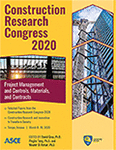Construction Research Congress 2020
How Induced Seismicity Impacts Community Perceptions of Oil and Gas Development
Publication: Construction Research Congress 2020: Project Management and Controls, Materials, and Contracts
ABSTRACT
In the central United States, the frequency of earthquakes has risen significantly in the past decade. Many scientists have argued that these earthquakes are induced by injecting vast quantities of salty wastewater, a byproduct of oil and natural gas production via hydraulic fracturing, deep underground. Because of the connection to oil and gas production, these earthquakes may influence people’s perceptions of the petroleum industry, including the effect the industry has on their community and whether they support or oppose hydraulic fracturing. This work presents the results of a household survey conducted in four geographic regions across Oklahoma and Colorado that have significant levels of oil and gas production and varying levels of recent human-induced earthquakes. Our results show that earthquakes impact views of oil and gas development; specifically, the more negative of an impact that the earthquakes have on an individual’s life, the more negative the individual perceives the impacts of oil and gas development in their community and the less they support hydraulic fracturing generally. As our petroleum infrastructure is expanded it will be crucial for managers and planners to account for both the risks posed by induced seismicity as well as the public’s response to these new developments.
Get full access to this article
View all available purchase options and get full access to this chapter.
ACKNOWLEDGEMENTS
The material presented is based in part on work supported by the National Science Foundation under Grant No. 1520846. Any opinions, findings, and conclusions or recommendations expressed in this material are those of the authors and do not necessarily reflect the views of the National Science Foundation.
REFERENCES
Associated Press. (2016). “The Latest: Oklahoma governor declares emergency after quake.” APNews.com.
Boudet, H., Bugden, D., Zanocco, C., and Maibach, E. (2016). “The effect of industry activities on public support for ‘fracking.’” Environmental Politics, 25(4), 593–612.
Boudet, H. S., Zanocco, C. M., Howe, P. D., and Clarke, C. E. (2018). “The Effect of Geographic Proximity to Unconventional Oil and Gas Development on Public Support for Hydraulic Fracturing.” Risk Analysis, 0(0).
Brasier, K. J., Filteau, M. R., McLaughlin, Diane K., Jacquet, Jeffrey, Stedman, Richard C., Kelsey, Timothy W., and Goetz, Stephan J. (2011). “Residents’ Perceptions of Community and Environmental Impacts from Development of Natural Gas in the Marcellus Shale: A Comparison of Pennsylvania and New York Cases.” Journal of Rural Social Sciences, 26(1), 32–61.
Brown, M. R. M., Ge, S., Sheehan, A. F., and Nakai, J. S. (2017). “Evaluating the effectiveness of induced seismicity mitigation: Numerical modeling of wastewater injection near Greeley, Colorado: Modeling Wastewater Injection, Greeley.” Journal of Geophysical Research: Solid Earth, 122(8), 6569–6582.
Ellsworth, W. L. (2013). “Injection-induced earthquakes.” Science, 341(6142), 1225942.
FMI. (2018). 2019 FMI Overview.
Folger, P., and Tiemann, M. (2016). Human-Induced Earthquakes from Deep-Well Injection: A Brief Overview. Congressional Research Service, 36.
Freudenburg, W. R., and Davidson, D. J. (2007). “Nuclear Families and Nuclear Risks: The Effects of Gender, Geography, and Progeny on Attitudes toward a Nuclear Waste Facility*.” Rural Sociology, 72(2), 215–243.
Judd, C. M., McClelland, G. H., and Ryan, C. S. (2017). Data Analysis: A Model Comparison Approach to Regression, ANOVA, and Beyond. Routledge, New York.
Nakai, J. S., Weingarten, M., Sheehan, A. F., Bilek, S. L., and Ge, S. (2017). “A Possible Causative Mechanism of Raton Basin, New Mexico and Colorado Earthquakes Using Recent Seismicity Patterns and Pore Pressure Modeling: Earthquakes in the Raton Basin.” Journal of Geophysical Research: Solid Earth, 122(10), 8051–8065.
Neville, K. J., and Weinthal, E. (2016). “Scaling up site disputes: strategies to redefine ‘local’ in the fight against fracking.” Environmental Politics, 25(4), 569–592.
Pless, J. (2012). “Natural Gas Development and Hydraulic Fracturing.”
Rubinstein, J. L., and Mahani, A. B. (2015). “Myths and Facts on Wastewater Injection, Hydraulic Fracturing, Enhanced Oil Recovery, and Induced Seismicity.” Seismological Research Letters, 86(4), 1060–1067.
Stedman, R. C., Jacquet, J. B., Filteau, M. R., Willits, F. K., Brasier, K. J., and McLaughlin, D. K. (2012). “Marcellus Shale Gas Development and New Boomtown Research: Views of New York and Pennsylvania Residents.” Environmental Practice, 14(2), 382–393.
Swofford, J., and Slattery, M. (2010). “Public attitudes of wind energy in Texas: Local communities in close proximity to wind farms and their effect on decision-making.” Energy Policy, 38(5), 2508–2519.
Theodori, G. L. (2009). “PARADOXICAL PERCEPTIONS OF PROBLEMS ASSOCIATED WITH UNCONVENTIONAL NATURAL GAS DEVELOPMENT*.” Southern Rural Sociology, 24(3), 97.
US Census Bureau. (2019). “United States Census Bureau Quick Facts.” https://www.census.gov/quickfacts/fact/table/edmondcityoklahoma/PST045216.
U.S. Energy Information Administration. (2016). Hydraulic fracturing accounts for about half of current U.S. crude oil production. Today in Energy.
U.S. Energy Information Administration. (2019). “Petroleum & Other Liquids: Production.” U.S. Energy Information Administration, Spreadsheet.
USGS. (2019). “USGS Earthquakes Hazard Program.” Latest Earthquakes, Database, https://earthquake.usgs.gov/earthquakes/.
USGS, and Oklahoma Geological Survey. (2019). “Oklahoma Earthquakes Magnitude 3.0 and Greater.”
Wobbekind, R., and Lewandowski, B. (2015). Oil and Gas Industry Economic and Fiscal Contributions in Colorado by County, 2014. University of Colorado Boulder, 24.
Yeck, W. L., Sheehan, A. F., Benz, H. M., Weingarten, M., and Nakai, J. (2016). “Rapid Response, Monitoring, and Mitigation of Induced Seismicity near Greeley, Colorado.” Seismological Research Letters, 87(4), 837–847.
Information & Authors
Information
Published In
Construction Research Congress 2020: Project Management and Controls, Materials, and Contracts
Pages: 241 - 248
Editors: David Grau, Ph.D., Arizona State University, Pingbo Tang, Ph.D., Arizona State University, and Mounir El Asmar, Ph.D., Arizona State University
ISBN (Online): 978-0-7844-8288-9
Copyright
© 2020 American Society of Civil Engineers.
History
Published online: Nov 9, 2020
Published in print: Nov 9, 2020
Authors
Metrics & Citations
Metrics
Citations
Download citation
If you have the appropriate software installed, you can download article citation data to the citation manager of your choice. Simply select your manager software from the list below and click Download.
